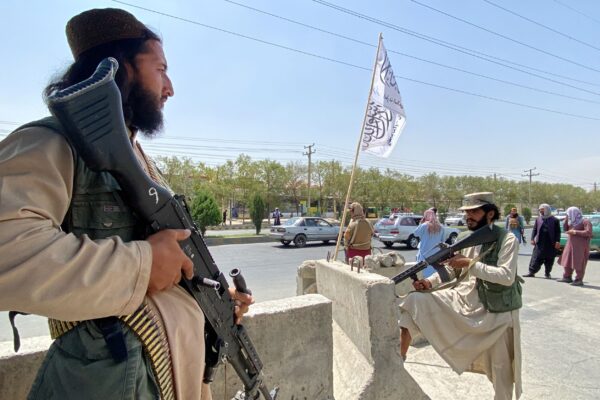Likely billions of dollars of American weapons and vehicles are now in the hands of the Taliban extremist group after the collapse of the Afghan government and army, with numerous videos and photos surfacing online showing Taliban members seizing the equipment.
Photos have circulated of Taliban members holding American M-4 carbines and M-16 rifles rather than AK-47s or AKMs. Other images and videos showed the Taliban surrounding U.S. Black Hawk helicopters and A-29 Super Tucano attack aircraft.
On Wednesday, several GOP senators demanded the Department of Defense (DOD) provide full accounting over the weapons and equipment that were captured by the Taliban, considered by several agencies as a terrorist organization.
“As we watched the images coming out of Afghanistan as the Taliban retook the country, we were horrified to see U.S. equipment—including UH-60 Black Hawks—in the hands of the Taliban,” Sens. Marco Rubio (R-Fla.), Bill Cassidy (R-La.) and two dozen other senators wrote to Pentagon chief Lloyd Austin this week.
“It is unconscionable that high-tech military equipment paid for by U.S. taxpayers has fallen into the hands of the Taliban and their terrorist allies,” the Republicans added. “Securing U.S. assets should have been among the top priorities for the U.S. Department of Defense prior to announcing the withdrawal from Afghanistan.”
Some experts said that the Taliban capture of U.S. hardware has more of a psychological impact—rather than a practical impact.
“When an armed group gets their hands on American-made weaponry, it’s sort of a status symbol. It’s a psychological win,” said Elias Yousif, deputy director of the Center for International Policy’s Security Assistance Monitor, according to The Hill.
Yousif said the development is problematic for a number of reasons.
“Clearly, this is an indictment of the U.S. security cooperation enterprise broadly,” he added. “It really should raise a lot of concerns about what is the wider enterprise that is going on every single day, whether that’s in the Middle East, Sub-Saharan Africa, East Asia.”


The Office of the Special Inspector General for Afghanistan Reconstruction, established by Congress in 2008, has said that about $83 billion was spent on developing and sustaining the Afghan police and army over two decades. Between 2003 and 2016, the United States transferred nearly 600,000 weapons, 76,000 vehicles, 163,000 communication devices, 208 aircraft, and surveillance and reconnaissance equipment to the Afghan forces, said a 2017 Government Accountability Office report.
Between 2017 and 2019, the United States provided Afghan army forces with 4,702 Humvees, 2,520 bombs, 1,394 grenade launchers, 20,040 hand grenades, and 7,035 machine guns, said the Office of the Special Inspector General for Afghanistan Reconstruction.
Yousif told The Hill that it’s likely the Taliban would be able to use advanced aircraft or weaponry but stressed they won’t be able to keep the aircraft in the air for long.
“They may be able to manage a flight or two or to operate them in some really limited capacity in the short term, but without long-term sustainment, maintenance, servicing, that sort of thing, it wouldn’t turn into a robust or useful military capability,” he said. “It took the Afghans and the United States a long time to develop an indigenous air capability, and even then, they were reliant on the United States to keep those planes in the sky.”
Small arms like M-16s, he said, are of more concern.
“They are easy to maintain, easy to learn how to use, easy to transport,” Yousif told the outlet. “The concern for all small arms is that they are durable goods and they can be transferred, sold. We’ve seen this before where a conflict ends and the arms that stay there make their way to all parts of the world.”
When pressed for comment, White House officials said that it’s not clear how many weapons or vehicles were seized.
“We don’t have a complete picture, obviously, of where every article of defense materials has gone, but certainly a fair amount of it has fallen into the hands of the Taliban,” White House national security adviser Jake Sullivan told reporters on Tuesday. “And obviously, we don’t have a sense that they are going to readily hand it over to us at the airport.”
And Sullivan made reference to the Black Hawk helicopters that were taken, blaming the Afghan army for not defending themselves.
“Those Black Hawks were not given to the Taliban,” he said. “They were given to the Afghan National Security Forces to be able to defend themselves at the specific request of [Afghan] President [Ashraf] Ghani, who came to the Oval Office and asked for additional air capability, among other things.”


